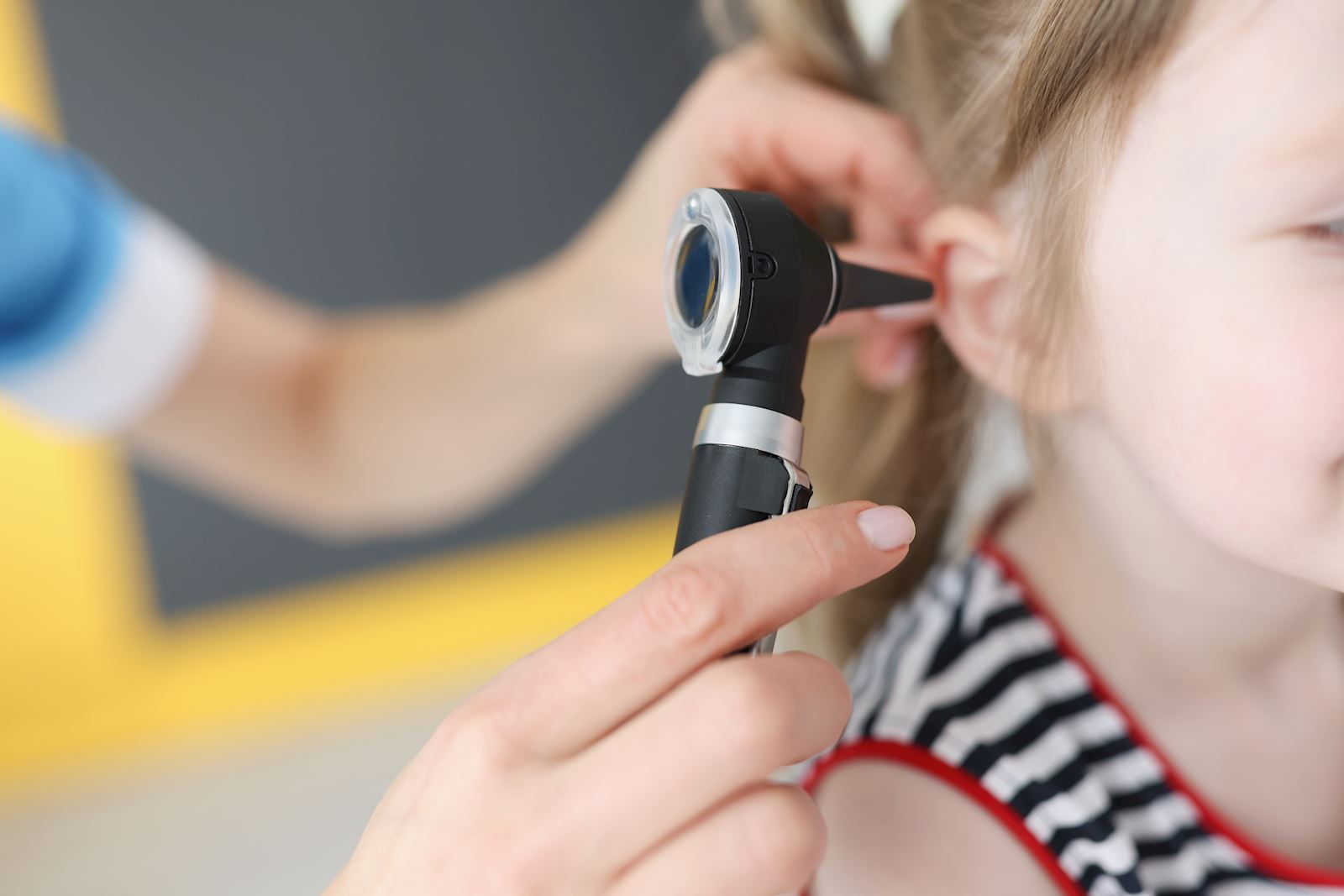Sometimes it feels like your child just isn’t paying attention. But what if they’re actually having trouble hearing? It’s common for kids to seem distracted but hearing problems do happen, and it’s important to recognize the signs early.
The good news? Most hearing concerns in kids aren’t permanent and can be treated successfully. There’s a broad range of hearing loss in children, with a variety of treatments to match.
The most common type of hearing loss in children is only temporary.
The most common cause is something called conductive hearing loss. This happens when there’s a problem in the outer or middle ear. For kids, this is usually from fluid buildup, ear infections, or something stuck in the ear like wax or a small object.
Once these are treated or removed, hearing likely returns to normal.
“Ear infections and fluid behind the eardrum are common in young children, especially during cold and allergy seasons,” says Rebecca Waymire, AuD, a West Des Moines audiologist with The Iowa Clinic. “Fortunately, these are typically temporary and easily treatable problems.”
In rare other cases, a child may have structural abnormalities or growths in the ear that affect hearing, but most can be managed with medical or surgical care.
Watch for these signs that your child can’t hear.
It’s not always easy to tell if a child can’t hear well, especially if they’re very young and can’t say what they’re experiencing. Believe it or not, it’s even harder to tell the difference between your child tuning you out and them having trouble hearing you all together. Because as they get older, they develop different ways to compensate and adapt.
At every age, you have to look at other cues.
1. They pull and tug at their ears.
This can mean something is bothering their ear, like wax or fluid. Your child’s ears may be red from all the attention – another sign that the ear issue is not just an itch but a nagging issue.
2. Your young child has trouble sleeping.
Fluid in the ear can cause discomfort, making it hard for your child to sleep well.
“It can cause issues with sleep,” says. Dr Waymire. “They don’t sleep well at night because the fluid pushes up against the eardrum when they lay flat.”
3. Your infant shows delays in their speech development.
Speech and language development in young children is 80% incidental. Children learn to talk by hearing others in their natural environment. If your child isn’t responding to sounds or isn’t talking as much as other kids their age, it could be a sign.
“As children get closer to 1 and 2, you start to see those delays in their speech development, and children will begin to express frustration in their ability to communicate,” Dr. Waymire says. “They don’t react to someone’s voice. When you hold them or try to get their attention after multiple attempts, they don’t respond. Those could be other indications as well.”
4. Their hearing seems inconsistent.
When your child is a little older and able to understand and communicate, you will notice other cues. They may want the TV turned up louder than the rest of the family. They may hear you fine sometimes but not even register a response to others. When they do, it’s “Huh?” or “What?”
You might think these are normal kid behaviors when they could be signs of unidentified hearing loss.
5. They’ve developed adaptive behaviors.
Turning up the TV, replying “Huh?” and asking you to repeat yourself are all ways kids can compensate for their hearing troubles. Your child may show physical behavior too. Like sitting closer to a source of sound. Moving their head or “good ear” toward you in conversation. Or watching your face and mannerisms intently to collect visual cues.
They may show signs in the school setting, too.
Children who are experiencing hearing problems might display these concerning behaviors in the school setting:
- Concerns with behavior or attention
- Slow transition from activity to activity
- Concerns with academics (particularly reading and writing)
- Often showing a look of confusion
- Frequent prompts from the teacher to begin a task
- Frequent clarity questions from the child to the teacher
- Appearing more tired at the end of each school day
“If any of these concerning behaviors are witnessed by the school, the child's hearing as a concern should be ruled out in conjunction to interventions provided by the school,” says Dr. Waymire. “Hearing is one of the necessities needed to be successful in school.”
It’s always best to start with a hearing test.
A hearing screening is one of the first tests every newborn takes in the hospital. Once your child hits school age, they will likely have standard hearing tests in the schools.
Pure tone audiometry is the standard for older kids and adults. Younger children aren’t capable of understanding the test and responding to the beeps, so there are different, age-appropriate hearing tests:
- Otoacoustic emission test (OAE) – The universal newborn hearing screening used in hospitals, OAE sends sound into a child’s ear. How the sound is reflected back tells audiologists whether or not there is hearing loss.
- Auditory Brainstem Response (ABR) – If your child failed the OAE (in the hospital or otherwise), ABR is the next step. Electrodes placed on the head transmit clicks and tones into the brain. The readings show the actual degree of concern of hearing loss, rather than the simple pass/fail of an OAE test.
- Visual reinforcement audiometry – Similar to pure tone audiometry, children as young as 6 months old sit in the sound booth with their parents. Instead of headphones and hand raising, tones are piped in through a speaker and an audiologist watches to see whether your child turns their head toward the sound.
- Play audiometry – This test turns pure tone audiometry into a game. Your child is prompted to respond to beeps by dropping a block into a bucket. When they do it correctly, they’re praised to reinforce the response and encourage the play.
Temporary or not, you have treatment options.
The type of treatment depends on the cause of the hearing loss. For obstructions, removal is the only route. You must take out the wax, object or deformity that’s hindering hearing. Other causes of hearing loss have a bit more flexibility with treatments.
“If it’s fluid or infection, typically the first step would be antibiotics through the child’s Pediatrician.,” Dr. Waymire says. “But if it’s a long-term history of fluid — if you’ve tried 3 or 4 antibiotics and it’s chronic — our next step is to proceed with tubes.”
For severe and permanent types of hearing loss, hearing aids are a definite need. There’s just no better option. Parents should consult with a pediatric audiologist to determine the effect the degree and type of hearing loss present in their child.
“If your child is right on the borderline or only has mild loss at one or two frequencies, you can try other things,” Dr. Waymire says. “If they sit closer to the source of instruction or with their better ear toward the teacher, they do much better than in the back where they have ambient background noise interfering.”
There are many variables that go into deciding if hearing aids are needed for a pediatric patient, so it's important to discuss your options with a pediatric audiologist.
If you or a teacher have seen signs of hearing loss, or your child failed a hearing screening at school, you can schedule hearing testing with an audiologist. And, see an ear, nose and throat doctor, all in one visit. Call 515.875.9450 or schedule online today.

